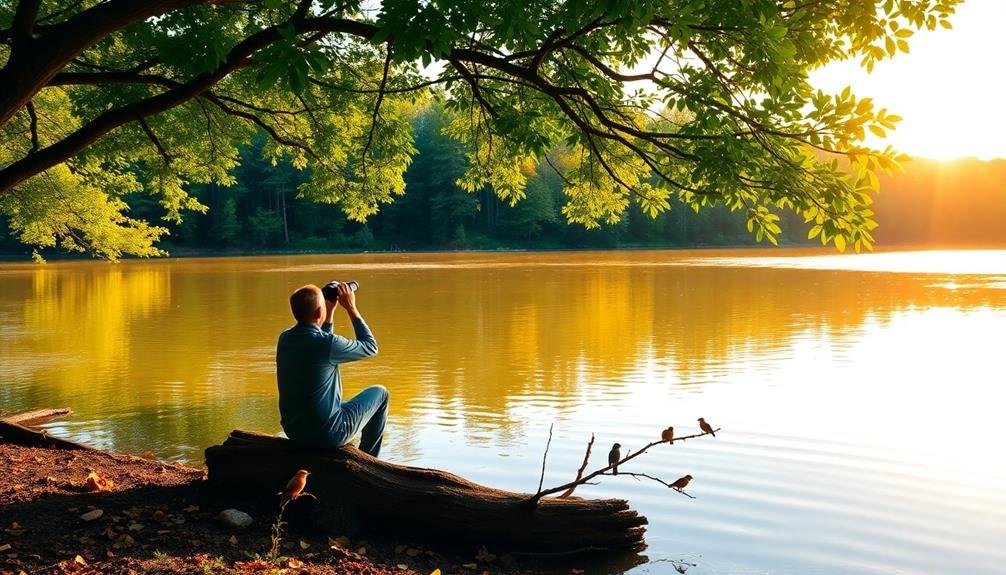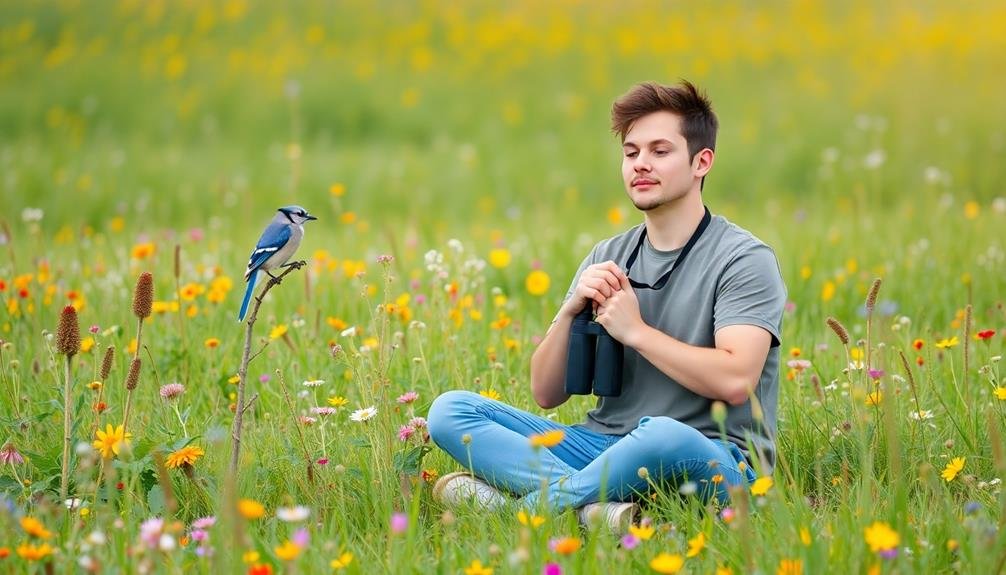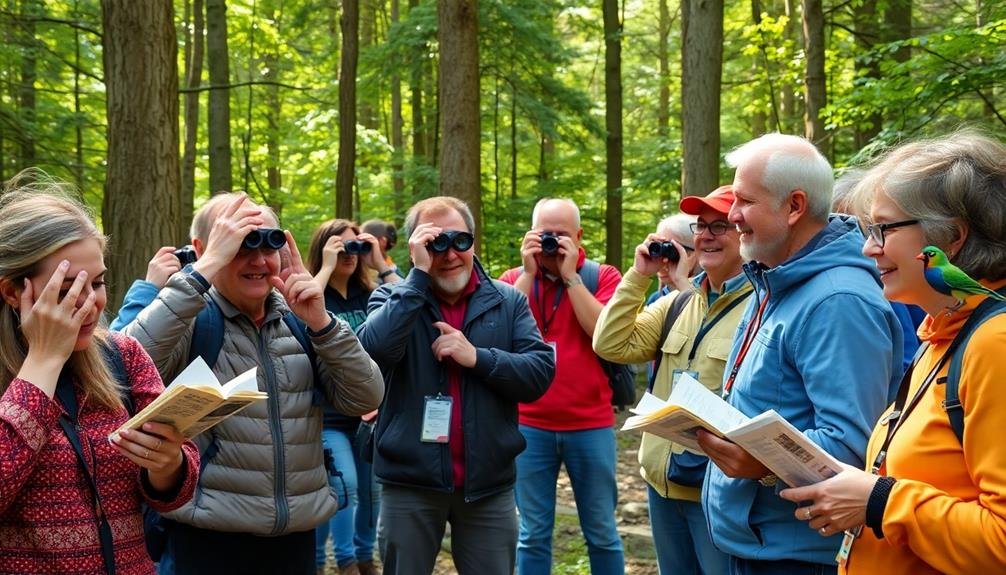To ease anxiety through birdwatching, start by choosing a peaceful location away from busy trails. Bring essential gear like binoculars and a field guide to feel prepared. Practice mindful observation techniques, focusing on patience and stillness to connect with nature. Learn bird calls and songs to enhance your experience and deepen your engagement. Joining a birdwatching community can provide support and shared learning opportunities. Remember to wear comfortable clothing and stay hydrated. As you immerse yourself in the sights and sounds of birds, you'll likely find your worries fading away. These tips are just the beginning of your journey to tranquility through birdwatching.
Choose a Peaceful Birdwatching Spot

Nature's quieter corners offer the best birdwatching experiences. To find these serene spots, research local parks, nature reserves, or wildlife sanctuaries in your area. Look for locations with diverse habitats, such as wetlands, forests, or meadows, as these attract a variety of bird species.
When you arrive at your chosen spot, seek out areas away from busy trails or noisy attractions. Listen for bird calls and look for signs of activity, like rustling leaves or movement in trees.
Don't forget to take into account the time of day; early mornings and late afternoons are often prime times for bird activity.
Choose a comfortable place to settle in, preferably with a good view of the surrounding area. Bring a portable chair or blanket if you plan to stay for a while.
Make sure you're not disturbing nesting sites or blocking wildlife corridors.
Bring Essential Gear
Once you've found the perfect spot, it's time to guarantee you're properly equipped for your birdwatching adventure.
Start with a reliable pair of binoculars, ideally 8×42 or 10×42 magnification, to get a clear view of distant birds. Don't forget a field guide or smartphone app to help identify the species you encounter.
Comfort is key, so wear weather-appropriate clothing and sturdy, waterproof shoes. Pack sunscreen, insect repellent, and a hat to protect yourself from the elements.
Bring a reusable water bottle and some light snacks to stay hydrated and energized during your outing.
A small notebook and pen are essential for jotting down observations and sketching birds you see. Consider bringing a camera to capture memorable moments or help with later identification.
A lightweight, foldable chair or cushion can provide comfort during extended periods of watching.
For longer excursions, pack a first-aid kit and a fully charged cell phone for safety.
Practice Mindful Observation Techniques

Successful birdwatching relies on three key observation techniques. First, practice patience and stillness. Find a comfortable spot, remain quiet, and let the birds come to you. Second, use all your senses. Listen for calls and songs, watch for movement, and even pay attention to subtle changes in the environment. Third, develop your visual scanning skills. Regularly sweep your eyes across the landscape, focusing on different depths and areas.
To enhance your mindful observation, try these techniques:
| Technique | Description |
|---|---|
| 3-2-1 Method | Focus on 3 sounds, 2 sights, 1 sensation |
| Breath Awareness | Sync your breathing with nature's rhythm |
| Color Meditation | Identify different shades of one color |
| Gratitude Practice | Mentally note things you're grateful for |
As you apply these methods, you'll find yourself becoming more present and aware of your surroundings. This heightened state of mindfulness not only improves your birdwatching skills but also helps reduce anxiety and stress. Remember, the goal isn't just to spot birds but to immerse yourself in the natural world fully. With practice, you'll develop a deeper connection to nature and find greater peace in outdoor spaces.
Learn Bird Calls and Songs
Beyond visual identification, learning bird calls and songs opens up a whole new dimension of birdwatching. You'll discover birds you can't see, hidden in dense foliage or active at night. Start by focusing on common birds in your area. Listen carefully to their unique vocalizations and try to memorize them. Use bird call apps or online resources to compare what you hear with recorded sounds.
Practice imitating bird calls yourself. This technique helps you internalize the sounds and can even attract birds closer for better observation. Pay attention to the rhythm, pitch, and pattern of each call. Some birds have distinct alarm calls, mating songs, and territorial vocalizations.
Keep a journal of the bird sounds you've learned, noting any mnemonics that help you remember them. For example, the Eastern Towhee's call sounds like "drink-your-tea."
As you become more proficient, challenge yourself to identify birds solely by their sounds during your outings. This skill will enhance your birdwatching experience and deepen your connection with nature, potentially reducing anxiety and promoting relaxation in outdoor settings.
Join a Birdwatching Community

While birdwatching can be a solitary hobby, joining a birdwatching community can greatly enhance your experience and knowledge.
You'll find like-minded individuals who share your passion and can offer valuable insights. Local birding groups often organize outings, workshops, and events that provide opportunities to learn from experienced birders and explore new habitats.
To get involved in a birdwatching community, consider these steps:
- Search online for local Audubon Society chapters or birding clubs in your area
- Attend a meeting or event to meet fellow birders and learn about upcoming activities
- Participate in citizen science projects like the Christmas Bird Count or eBird
- Join online forums or social media groups dedicated to birdwatching
Frequently Asked Questions
How Can I Identify Birds Without Disturbing Them?
You can identify birds without disturbing them by using binoculars, listening to their calls, and observing their behavior from a distance. Take note of their size, shape, colors, and habitat. Field guides and bird ID apps can help too.
What Time of Day Is Best for Birdwatching?
You'll find early morning is prime time for birdwatching. Birds are most active at dawn, foraging for food. Dusk is another great option. During these times, you'll see and hear more species than midday.
Are There Any Smartphone Apps That Can Help With Bird Identification?
Yes, there are several helpful bird identification apps. You'll find Merlin Bird ID, eBird, and Audubon Bird Guide particularly useful. They offer photo recognition, bird calls, and detailed information. Download one and you'll be identifying birds like a pro in no time.
How Can I Attract More Birds to My Backyard for Observation?
You'll attract more birds by providing food, water, and shelter. Install bird feeders with diverse seeds, set up a birdbath, and plant native trees and shrubs. Add nesting boxes and create a pesticide-free environment to encourage avian visitors.
What Precautions Should I Take When Birdwatching in Remote Areas?
When birdwatching in remote areas, you'll want to bring a map, compass, and first-aid kit. Tell someone your plans, wear appropriate clothing, and carry plenty of water. Stay aware of your surroundings and potential wildlife encounters.
In Summary
You've now got the tools to make birdwatching a calming outdoor activity. Remember, it's not about spotting the rarest birds; it's about connecting with nature and finding peace. As you practice these tips, you'll likely find your anxiety easing and your appreciation for the natural world growing. Don't be surprised if birdwatching becomes your go-to method for relaxation and mindfulness. Embrace this hobby, and let the birds guide you to tranquility.





Leave a Reply